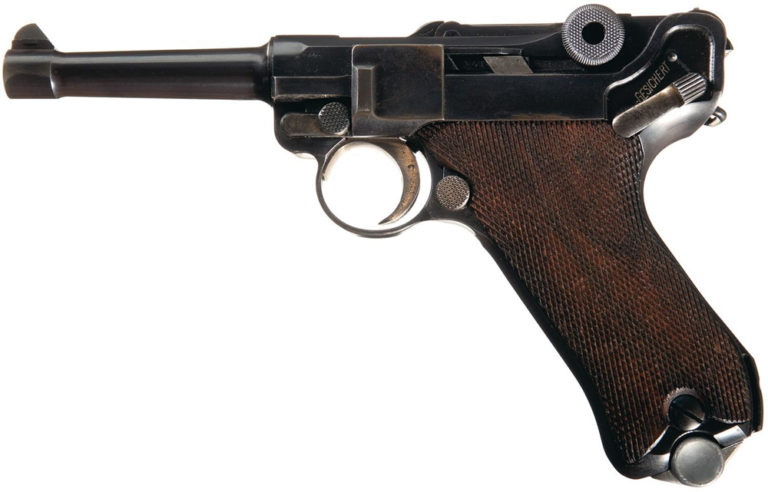
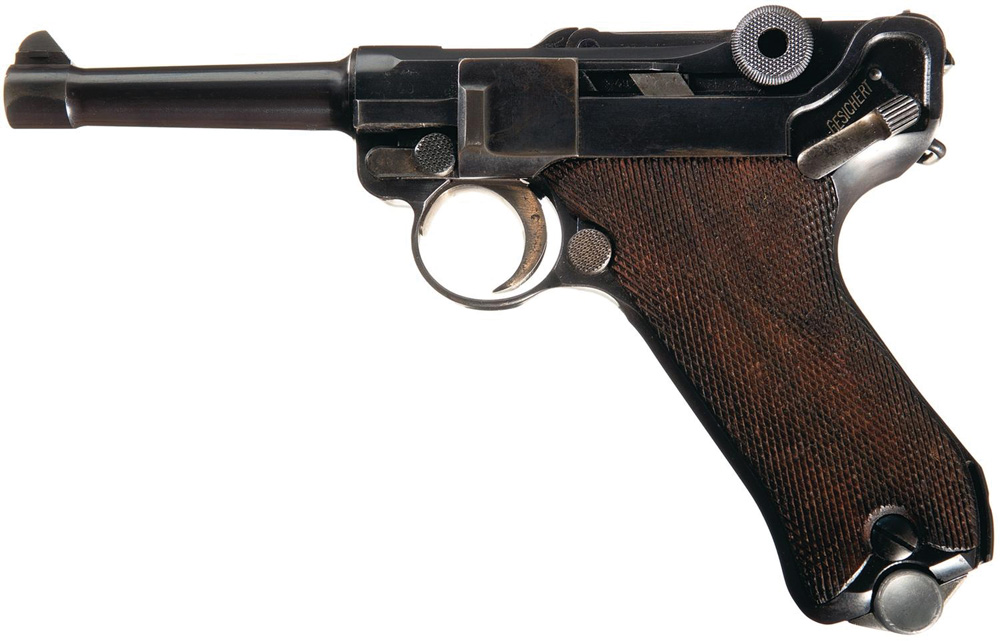
Collecting the timeless gunfighting pistols: The Luger, the 1911A1 and Single Action Army.
The three greatest gunfighting pistols of all time, based on the number of kills and casualties made with them, are the Luger, the M1911A1 and the Colt Single Action Army. The circumstances surrounding these exploits are not likely to ever be duplicated again so their positions seem safe for all time.
The Luger
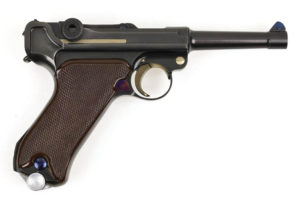
Used worldwide in the first part of the 20th century, the Luger saw its greatest action in German hands during the two World Wars. It was during the First World War that it earned the distinction of being the only pistol that was a major tactical weapon capable of winning a war. But for the entry of the United States in the war, it likely would have tipped the scales in Germany’s favor.
The story is rarely told today, as the victors write the history books and the losers’ exploits are often deliberately left out whenever the history re-writers can get away with it. Such is the case with the story of the Luger.
While World War I was defined by barbed wire, machine guns and artillery, combat in the trenches was an incredibly close-quarters battle. Entrenching tools and knives often had the advantage over rifles and bayonets in the crush of battle in the confined spaces of the trenches. This is where a pistol is best. Even at the closest quarters you can hold off your enemy with your left hand while you shoot him with the pistol in your right.
It was reported that the British and the French were reluctant to issue pistols to all of their rank and file because the soldiers were mutinying in large numbers. Also, the pistol was still an officer’s badge of rank and something that just wasn’t shared with enlisted men.
The German army had a different attitude. It was run like a very strict authoritarian family. Mutiny was never a consideration. When the troops needed pistols the Fatherland set out to supply them, despite the fact that the Luger pistol cost three times as much to manufacture as the Mauser rifle.
The Luger proved up to the challenge. It took in stride the mud, dust and sand maelstrom that was a WWI artillery barrage and kept on working when the famed Smith & Wesson Triple-Lock Revolvers were jamming. It would continue firing when its barrel was bulged from being clogged with mud. A Browning-style gun with the slide over the barrel is jammed solid until a new barrel can be installed when its barrel is bulged.
This feature saved so many German lives in the First World War that when the P38 was designed, the army specifications demanded a fully exposed barrel on it. All the Luger needs for reliability is a magazine spring that is as strong as you can get in the magazine and proper ammo—standard velocity ammo of the proper overall length. Hot loads cycle the action too fast for the magazine to feed cartridges in position to chamber before the bolt rides them down. This was never a problem with German army issue ammo.
A larger problem was the fact that the average German soldier was not a pistol shooter. The Luger handled that problem better than any pistol before or since. The Luger is the best pointing pistol ever made, bar none. Just point at the target and you hit it. It is as simple as that. It is also the most accurate pistol you will ever find. Most any good Luger will shoot a 10mm group with 9mm ammo at 25 yards.
Armed with the Luger the German troops proved a terror in trench fighting. Every stormtrooper was issued one regardless of rank, and production was geared up to equip every combat soldier by late 1918 or 1919. The Luger was a key factor in the new stormtrooper tactics as well as the new infiltration strategies of General Von Hutier and Colonel Bruchmuller, which had knocked Russia out of the war. The intensity of the trench fighting and the number of kills made by the Luger was staggering.
World War II saw more intense fighting with the Luger often being used against Russian human-wave assaults. Sometimes it was the officer’s only weapon and sometimes it was the last thing he had loaded magazines for. At those close ranges one could hardly miss. Once more the tally went up drastically. Add to these figures the numbers of the other countries’ armies that used the Luger and you get a number far exceeding any other pistol.
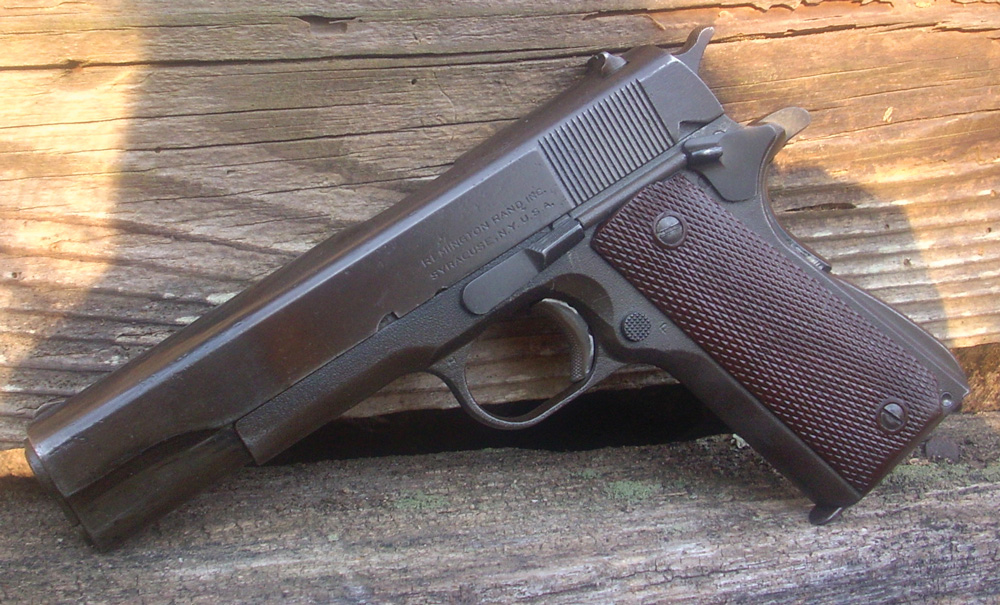
The 1911A1
The number two spot in numbers of enemies killed should go to the M1911A1 .45. During the first part of the 20th century Americans took great pride in their skill with a pistol. There have always been American soldiers who prefer the pistol to the rifle at close range, “close range” being a relative term that some will take out to 100 yards or more. Nothing is faster on target than a pistol and that fact has saved the life of many a pistoleer in combat.
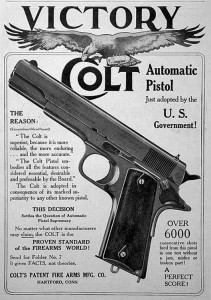
Ramping up pistol production took priority over rifle production when America entered WWI. Unlike the French and British, the Americans were quick to issue pistols to anyone who needed one. WWII saw more handgun use with house-to-house and jungle fighting all within easy pistol range.
Americans got their first look at human-wave assaults with the Japanese banzai charges in the Pacific Theater. They experienced them again in Korea when the Chinese communists obeyed their Russian advisors and launched the same sort of human-wave assaults Russia had used against Germany in WWII. The M1911A1 has also seen close-quarters fighting in Vietnam and subsequent wars.
The M1911A1 is the most reliable pistol in harsh conditions that is possible to make. I have seen an M1911A1 throw sand out of every joint with the first shot and keep on firing. An unaltered military M1911A1 will tolerate more rust, dust, sand and mud than any pistol ever made and continue to fight.
Its FMJ 230-grain bullet is a sure fight stopper with a hit to the vitals. It is a natural pointer, and with a little practice many shooters can’t seem to miss with it. My Betty has shot every coin out of the air with one as long as I had pocket change to throw for her. While it comes in second to the Luger in the number of people killed with it, the M1911A1 remains the ultimate fighting pistol.

Colt Single Action Army

Finally, we come to the classic gunfighter’s revolver, the Colt Single Action Army .45 Model of 1873. The old cowboy sixgun is what the public thinks of when they think of a gunfighter’s gun, although its tally of kills is below that of the Luger and M1911A1.
Most of its kills were racked up on the frontier where many a pistoleer insisted it was as accurate as a rifle out to long carbine ranges, and would proceed to prove it to any doubters.
Today’s shooters often can’t get the same results because they don’t grip it and cock it correctly. If you cock it like you would a double-action revolver with the thumb held lengthways behind the hammer, it will throw your grip low to the round bottom of the gun, and it will tend to shoot to one side or another without ever pointing very well.
The correct way is to lay the thumb crossways on the hammer and cock it as you would one of the old cap-and-ball Colts with the vertical hammer. This throws your grip high. You should have the cocked hammer forced against the top of your hand, with the ball of the hand behind the trigger finger squeezing one of the flat Colt logo panels, and the thumb squeezing against the other.
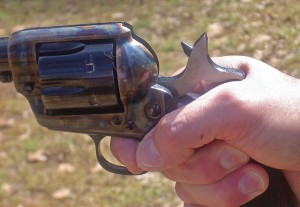
Put the first joint of the trigger finger over that narrow trigger, and if possible touch the tip of the trigger finger to the tip of the thumb. This puts the gun’s backstrap against the center of the palm of your hand. Squeezing the flat logo panels aligns the sights with whatever you are pointing at, and squeezing the trigger at the same time converts the act of pulling the trigger into a steadying affect, instead of disrupting the aim.
This is the only pistol I have shot like this. Many people say the single action rolls back in the hand with recoil. I have never felt any recoil nor have I experienced the gun moving in my hand with this grip. This is an old gunfighter’s secret and I believe I’m the only writer ever to put it in print.
The 19th century design of the SAA does have its limitations. Since it lacks a hammer bar safety like later revolvers, it must be carried with the hammer down over an empty chamber for safety. This is accomplished by loading one chamber, skipping one, loading four and then cocking. You can now lower the hammer down on an empty chamber.
Since it is almost as slow to reload as a cap-and-ball revolver using paper cartridges, you don’t want to take this gun into a gunfight where you have more than five opponents. However, it is so fast and sure with those five shots that you will find it an excellent choice for five or fewer enemies. The .45 Colt, like the .45 ACP, was designed to stop a 1,500-pound cavalry horse with one shot, which it does easily. Obviously, man stopping comes easy with either caliber.
These pistols all share an ease of accuracy due to the best pointing characteristics possible. They are all very reliable in service use – with the M1911A1 being the most reliable pistol of all time. Even today there is no handgun approaching its level of effectiveness in combat. Anyone planning on using a pistol for gunfighting should confine his search to these three.
This article is excerpted from the Gun Digest 2015 annual book.

Next Step: Get your FREE Printable Target Pack
Enhance your shooting precision with our 62 MOA Targets, perfect for rifles and handguns. Crafted in collaboration with Storm Tactical for accuracy and versatility.
Subscribe to the Gun Digest email newsletter and get your downloadable target pack sent straight to your inbox. Stay updated with the latest firearms info in the industry.

![Best Concealed Carry Guns In 2025 [Field Tested] Wilson Combat EDC X9S 1](https://gundigest.com/wp-content/uploads/Wilson-Combat-EDC-X9S-1-324x160.jpg)


![Best 9mm Carbine: Affordable PCCs [Tested] Ruger Carbine Shooting](https://gundigest.com/wp-content/uploads/Ruger-Carbine-Shooting-100x70.jpg)
![Best AR-15: Top Options Available Today [Field Tested] Harrington and Richardson PSA XM177E2 feature](https://gundigest.com/wp-content/uploads/Harrington-and-Richardson-PSA-XM177E2-feature-100x70.jpg)

I BELIEVE YOU ARE TALKING ABOUT THE MAUSER 1896 PISTOL BEFORE THEY WERE CONVERTED FROM THE ORIGINAL ROUND (7.63 X 25 mm ) WHICH WAS THE MOST POERFUL PISTOL ROUND UNTIL THE ADVENT OF THE .357 MAGNUM) TO THE 9 mm PARABELLUM ROUND IN WHICH THE PISTOL WAS NOW KNOWN AS THE RED 9. IF THIS IS THE PISTOL YOU ARE TALKING ABOUT (SINCE THE MAUSER 1896 IS COMMONLY KNOWN AS A RIFLE) YOU ARE CORRECT IN YOUR ASSESSMENT. IT WAS USED BY SO MANY DIFFERENT COUNTRIES IN SO MANY DIFFERENT WARS, PRIOR TO THE CREATION OF THE LUGER, AND WAS AN EASY TO USE BOX STYLE AUTOMATIC PISTOLS INITIALLY NAMED THE C96 UNTIL THEY WERE CONVERTED TO THE 9 MM ROUND. SO MANY COUNTRIES MANUFACTURED THEIR OWN COPIES USING DIFFERENT AMMO BUT MOST EITHER STAYED WITH THE 7.63 x 25 MM OR 9 MM PARABELLUM…AND, TO ME, THEY LOOKED LIKE AN EARLY VERSION OF THE LUGER. EVEN CHURCHILL USED ONE WHEN HE WAS IN THE MILITARY AND CLAIMED IT TO BE HIS FAVORITE PISTOL.
Correction: The C96 [1896 “Broomhandle” Mauser] was not “… known as a rifle…”, it was designed originally as a semi-sutomatic HANDGUN, which, as was the custon since long before the U.S. Civil War, was outfitted with a holster, which also served as a stock, in case the need arose for either volly fire, or aimed fire at greater distances.
Later there were numerous long barreled Commercial versions made as either Carbines, or take-down Carbines with detachable stocks, and a very few with detachable barrels, but were not capable of being fired without the stock, as there was no pistol grip on the lower frame.
When the C96 Mauser was later introduced in- NOT converted to- 9mm Parabellum, commonly known as the “Red Nine” due to the grips having an inletted and painted number “9” to differentiate them from the 7.63 Mauser cartridge chambered pistols, they were, indeed, still identified as the C96 Broomhandle Mauser Pistol.
The Luger, on the other hand, was derived from the Borchardt Pistol, designed by the American, Hugo Borchardt [who also designed the Sharps-Borchardt Rifle, among others]. When he could not find an American manufacturer to produce his pistol, he took it to Germany, in 1893, and they were mady by Ludwig Loewe & Company (later called Deutsche Waffen- und Munitionsfabriken).
The Borchardt design was redesigned by Georg Luger, who came up with the 7.65-millimetre [shortened 7.63 Mauser] Luger Pistol and evolved into what we know as the P-08 Luger, which was later adopted by the German military in 9mm Parabellum in 1908, .
I guess I’m going to disagree with your assement. The most leathal hand gun ever ” the Mauser 1896 On the market 1896 used in every war. Churchill carried one against the Bores. They were used WWl by Germans, and private ones by British, turkey. They kicked way up known as the Bolo for Bolsivicks, during RUSSIAN revolution, killing 10,000’s. China warlords, Nationals, red Chinese ordered 1,000’s from Mauser, and made their own even in 45acp. Murdered 100,000’s. They were manufactured in Spain and used by both sides. They continued on with Germany, Soviets, & nations, red Chinese through WWII. The Red Chinese used them through 1950’s to murder millions. Left out a lot, but you get my point.